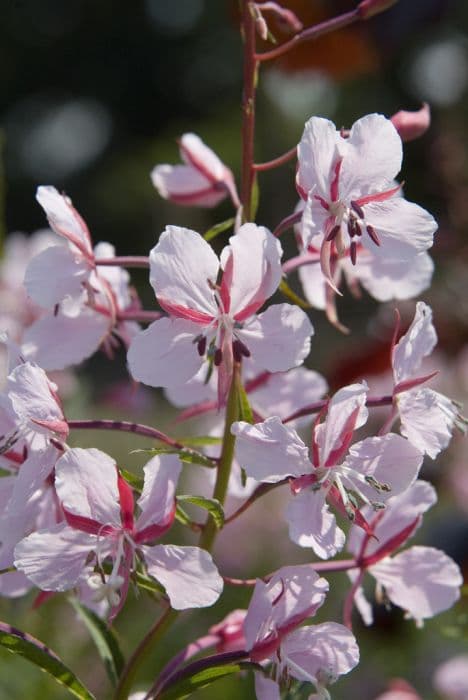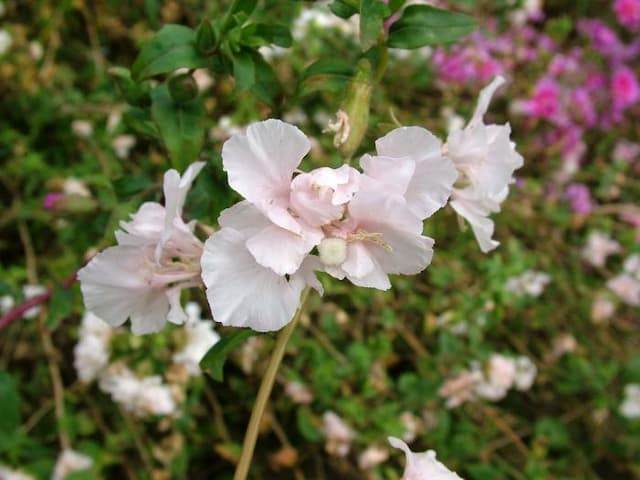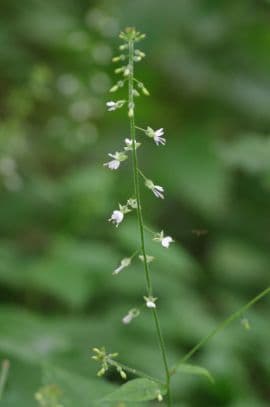Miniature Fuchsia Fuchsia microphylla (E)

ABOUT
The small-leaf fuchsia is a charming plant, celebrated for its profusion of dainty flowers and delicate foliage. Its hallmark feature is the tiny leaves that densely populate the slender branches, creating a fine-textured appearance that is both graceful and lush. The leaves are typically a vibrant green, harmonizing with the environment and adding a fresh, verdant hue to the setting in which the plant is placed. The blossoms of the small-leaf fuchsia are enchanting, usually appearing in multitudes and offering an eye-catching contrast against the foliage. These flowers are renowned for their unique shape, dangling from the branches like little lanterns or earrings. The petals are often brightly colored, with hues ranging from deep purples and pinks to reds, often accented with touches of white or lighter shades that enhance their intricate form. These blooms are not only beautiful but also attract a variety of pollinators, adding a lively dynamic to the plant's surroundings. The floral display is long-lasting, bringing color and interest to the area over an extended period. With each flower composed of a skirt-like structure beneath with elongated, curving petals above, they present a ballet of form and color that is truly delightful to observe. Though diminutive in leaf size, the small-leaf fuchsia is no less impressive, creating a texturally rich and floriferous display that can enhance any garden or container in which it is grown. It is a favorite among those who appreciate the subtle elegance of smaller foliage paired with the vibrant showiness of its blooms.
About this plant
 Names
NamesSynonyms
Small-Leaved Fuchsia, Miniature Fuchsia
Common names
Fuchsia microphylla subsp. hemsleyana, Fuchsia thymifolia subsp. minimiflora, Fuchsia thymifolia var. minimiflora.
 Toxicity
ToxicityTo humans
Fuchsia microphylla, commonly referred to as Fuchsia, generally is not considered poisonous to humans. However, if ingested in large quantities, some individuals might experience mild gastrointestinal discomfort. This might include symptoms such as nausea, vomiting, or diarrhea. It is always advisable to exercise caution and avoid ingesting any part of ornamental plants due to potential individual allergies or unpredictable reactions.
To pets
Fuchsia microphylla, known as Fuchsia, is not typically toxic to pets. It is considered to be low in toxicity, and consuming this plant is unlikely to cause harm to common household pets such as cats and dogs. However, some pets may have a sensitivity that could result in minor digestive upset if they ingest part of the plant, such as leaves or flowers. Symptoms could include vomiting or diarrhea, but serious consequences are not commonly reported. As with any non-food plant, it is best to prevent pets from chewing on it to avoid any potential issues.
 Characteristics
CharacteristicsLife cycle
Perennials
Foliage type
Semi-deciduous
Color of leaves
Green
Flower color
Pink
Height
2-3 feet (0.6-0.9 meters)
Spread
2-3 feet (0.6-0.9 meters)
Plant type
Shrub
Hardiness zones
9
Native area
Mexico
Benefits
 General Benefits
General Benefits- Ornamental Value: Fuchsia microphylla, commonly known as Small-leaved Fuchsia, is sought after for its decorative flowers which add aesthetic appeal to gardens and landscapes.
- Attracts Pollinators: The vibrant flowers are known to attract pollinators such as hummingbirds and bees, thus supporting local ecosystems.
- Variety of Habitats: Small-leaved Fuchsia is adaptable to various environments, making it suitable for different garden settings.
- Potential as Hedge Plant: Its dense foliage allows it to be used effectively as a hedging plant, providing structure and privacy to gardens.
- Low Maintenance: Fuchsia microphylla does not require extensive care once established, making it a convenient choice for gardeners of all skill levels.
- Long Blooming Period: The plant boasts a relatively long flowering season, providing color and interest for an extended period.
- Resilience to Pests: Small-leaved Fuchsia has a natural resilience to many common garden pests, reducing the need for chemical interventions.
 Medical Properties
Medical Properties- This plant is not used for medical purposes
 Air-purifying Qualities
Air-purifying QualitiesThis plant is not specifically known for air purifying qualities.
 Other Uses
Other Uses- Fuchsia microphylla can be used as a natural dye, as the crushed berries create a vibrant pink-purple color that can be transferred to fabrics or paper.
- The wood from Fuchsia microphylla is hard and fine-grained, making it suitable for creating small, specialized wooden objects like inlay work or detailed carvings.
- Due to its dense foliage, Fuchsia microphylla can be trained and trimmed to form intricate topiaries in ornamental gardens, adding an artistic touch.
- As an attractive and enduring plant, Fuchsia microphylla can play a role in bonsai gardening, offering a small-leaved option for enthusiasts to shape and display.
- Bird enthusiasts may plant Fuchsia microphylla to attract hummingbirds and other nectar-feeding birds into the garden, as its flowers are a good source of nectar.
- Fuchsia microphylla, with its pendulous flowers, can be used as a photographic subject or model in botanical illustration classes, teaching students about form and structure in plants.
- The plant can be grown in hanging baskets to provide spatial diversity and vertical interest in both indoor and outdoor garden displays.
- Fuchsia microphylla's flowers are sometimes used to decorate cakes or salads as an all-natural, edible garnish that provides a splash of color.
- During festivals or ceremonies, the branches with flowers of Fuchsia microphylla can be used for decorative purposes, such as making natural garlands or floral arrangements.
- Gardeners may use Fuchsia microphylla in fairy gardens to create a whimsical, miniature landscape due to its small leaves and dainty flowers.
Interesting Facts
 Feng Shui
Feng ShuiThe Fuchsia is not used in Feng Shui practice.
 Zodiac Sign Compitability
Zodiac Sign CompitabilityThe Fuchsia is not used in astrology practice.
 Plant Symbolism
Plant Symbolism- Elegance: Fuchsia microphylla, with its delicate hanging flowers, often symbolizes elegance and grace, reflecting its unique and artful appearance.
- Good Taste: Because of its ornate flowers, the fuchsia is also associated with good taste and sophistication in personal style and aesthetic preferences.
- Confiding Love: In the language of flowers, fuchsia can represent confiding love, expressing trust and intimacy in a relationship.
- Ambiguity: The complex structure of its blossoms can suggest complexity or ambiguity, possibly reflecting a relationship or situation that isn't straightforward.
 Water
WaterThe small fuchsia, also known as Fuchsia microphylla, should be watered when the top inch of soil feels dry. Generally, this may mean watering once or twice a week, depending on climate and indoor conditions. Use lukewarm water and add enough so that it runs through to the drainage holes—this could be up to half a gallon for a medium-sized pot every 7-10 days. Avoid allowing the plant to sit in water, as this can lead to root rot. During winter or in cooler temperatures, reduce watering frequency to match the plant's slower growth and reduced needs.
 Light
LightSmall fuchsia prefers bright, indirect light. It should be placed in a spot where it can receive plenty of light without being exposed to the harsh rays of the midday sun, such as near an east or west-facing window. Direct sunlight can lead to scorched leaves, while too little light can stifle blooming and cause leggy growth.
 Temperature
TemperatureSmall fuchsia thrives best in cooler temperatures, ideally between 55-75°F. It can survive temporarily outside of this range but should not be exposed to temperatures below 40°F or above 80°F. The ideal condition is to maintain a cool environment as hot temperatures can stress the plant and compromise its health.
 Pruning
PruningPrune small fuchsia to maintain its shape and to encourage bushier growth and more flowers. The best time to prune is in late winter or early spring before new growth begins. Deadheading, or removing spent flowers, should be done regularly to promote continuous blooming throughout the season.
 Cleaning
CleaningAs needed
 Soil
SoilSmall-leafed Fuchsia prefers a well-draining soil mix with peat moss, perlite, and loam in equal parts, with a slightly acidic to neutral pH of 6.0 to 7.0. Good drainage is essential to prevent waterlogging.
 Repotting
RepottingSmall-leafed Fuchsia should generally be repotted every two to three years to refresh the soil and accommodate root growth.
 Humidity & Misting
Humidity & MistingSmall-leafed Fuchsia thrives best in high humidity conditions, ideally between 60% and 70%.
 Suitable locations
Suitable locationsIndoor
Place Small-leafed Fuchsia in bright, indirect light with high humidity.
Outdoor
Grow Small-leafed Fuchsia in partial shade and shelter from strong winds.
Hardiness zone
9-11 USDA
 Life cycle
Life cycleFuchsia microphylla, commonly known as small-leaved fuchsia, begins its life cycle with seed germination, typically requiring a warm and moist environment to sprout. Following germination, it enters a vegetative growth phase, where it develops its characteristic small leaves and woody stems. In the flowering stage, small-leaved fuchsia produces delicate tubular flowers, often in shades of pink and purple, which are pollinated by hummingbirds or insects. After successful pollination, the flowers give way to small fruit that contain seeds, completing the reproductive cycle. In favorable conditions, small-leaved fuchsia can thrive and continue to grow for many years, often being treated as a perennial in mild climates. Throughout its life, the plant requires pruning to maintain a desired shape and encourage more prolific blooming.
 Propogation
PropogationPropogation time
Spring-Early Summer
Propogation: Fuchsia microphylla, commonly known as small-leaved fuchsia, can be propagated most effectively through cuttings. The ideal time for taking cuttings is late spring to early summer when the plant is actively growing. To propagate, choose healthy, non-flowering shoots of about 2 to 4 inches long. Cut just below a leaf node, as this is where new roots are most likely to form. Remove the lower leaves and dip the cut end in rooting hormone powder to encourage root growth. Plant the stem cutting in a mix of peat and perlite, ensuring the leaf node is beneath the soil surface, and keep the soil moist but not waterlogged. Cuttings typically root within three to four weeks, at which time they can be transplanted to a more permanent location.









